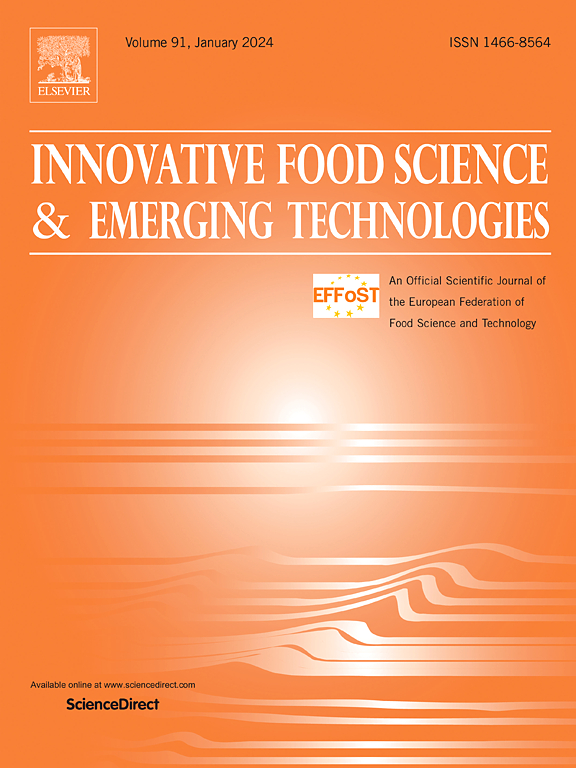高水分挤压大麻籽和燕麦压榨饼以形成含有大豆蛋白的纤维肉类似物:质地和物理化学性质
IF 6.8
1区 农林科学
Q1 FOOD SCIENCE & TECHNOLOGY
Innovative Food Science & Emerging Technologies
Pub Date : 2025-06-23
DOI:10.1016/j.ifset.2025.104094
引用次数: 0
摘要
高水分挤压(HME)是一项生产具有理想纤维结构的植物性肉类类似物的关键技术,本研究采用高水分挤压(HME)技术,以大麻籽压榨饼(HPC)、大豆分离蛋白(SPI)和燕麦压榨饼(OPC)为原料,分别以70:20:10和30:60:10 (HPC:SPI:OPC)的比例进行了配方开发。在不同的含水量(50、55和60%)和长冷却模温度(40、60和80°C)条件下对这些配方进行加工,以研究它们对挤压的肉类类似物的结构和物理化学性质的影响。偏最小二乘回归结果显示,HPC和含水量是影响材料理化性质的主要因素。低hpc配方在纹理剖面分析、标准和荧光成像以及蛋白质键分析的支持下,产生了具有结构弹性和纤维性的纹理。HPC增强了与熟肉相似的质地,降低了硬度、粘稠度和嚼劲,同时保持了相对较高的蛋白质水平。增加水分含量会软化挤出物,降低结构回弹性,而冷却模温度较长对挤出物的影响不大,在较高温度下会增强各向异性,促进蛋白质键的形成。蛋白质溶解度分析表明,稳定纤维结构的主要相互作用是氢键,其次是二硫键和疏水相互作用。成像分析证实了这些发现,揭示了低hpc配方中更有组织的蛋白质网络。HPC的加入在不损害结构完整性的情况下提高了营养价值。这项研究证明了在肉类类似物中使用升级回收的植物成分(如HPC和OPC)的可行性。通过成分和工艺优化,可以获得具有肉类质地的可持续和有营养价值的产品。本文章由计算机程序翻译,如有差异,请以英文原文为准。
High-moisture extrusion of hempseed and oat press cakes for formation of soy-protein-containing fibrous meat analogs: Textural and physicochemical properties
High-moisture extrusion (HME), a key technology for producing plant-based meat analogs with desirable fibrous structure, was applied in this study to develop formulations enriched with hempseed press cake (HPC), combined with soy protein isolate (SPI) and oat press cake (OPC) in ratios of 70:20:10 and 30:60:10 (HPC:SPI:OPC). These formulations were processed under different conditions of water content (50, 55, and 60 %) and long cooling die temperature (40, 60 and 80 °C) to investigate their effect on the textural and physicochemical properties of the extruded meat analogs. Partial least squares regression results revealed HPC and water content as the main drivers of textural and physicochemical properties. Low-HPC formulations yielded structurally resilient and fibrous textures, supported by texture profile analysis, standard and fluorescent imaging, and protein bond analyses. HPC enhanced the textural resemblance to cooked meat, reducing hardness, gumminess, and chewiness, while maintaining relatively high protein levels. Increasing water content softened the extrudates and decreased structural resilience, whereas long cooling die temperature had moderate influence, enhancing anisotropy and promoting protein bond formation at higher temperatures. Protein solubility assays indicated that hydrogen bonding was the dominant interaction stabilizing the fibrous structure, followed by disulfide bonding and hydrophobic interactions. Imaging analysis corroborated these findings, revealing more organized protein networks in low-HPC formulations. The incorporation of HPC improved nutritional value without compromising structural integrity. This study demonstrates the feasibility of using upcycled plant-based ingredients such as HPC and OPC in meat analogs. Through composition and process optimization, sustainable and nutritionally valuable products with meat-like texture can be achieved.
求助全文
通过发布文献求助,成功后即可免费获取论文全文。
去求助
来源期刊
CiteScore
12.00
自引率
6.10%
发文量
259
审稿时长
25 days
期刊介绍:
Innovative Food Science and Emerging Technologies (IFSET) aims to provide the highest quality original contributions and few, mainly upon invitation, reviews on and highly innovative developments in food science and emerging food process technologies. The significance of the results either for the science community or for industrial R&D groups must be specified. Papers submitted must be of highest scientific quality and only those advancing current scientific knowledge and understanding or with technical relevance will be considered.

 求助内容:
求助内容: 应助结果提醒方式:
应助结果提醒方式:


